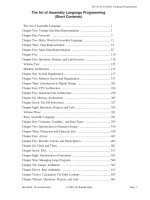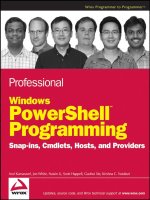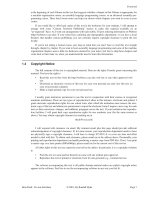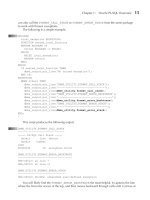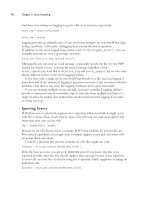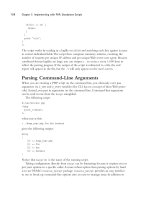Programming Scala ppt
Bạn đang xem bản rút gọn của tài liệu. Xem và tải ngay bản đầy đủ của tài liệu tại đây (3.37 MB, 448 trang )
Download at WoweBook.Com
Programming Scala
Download at WoweBook.Com
Download at WoweBook.Com
Programming Scala
Dean Wampler and Alex Payne
Beijing
•
Cambridge
•
Farnham
•
Köln
•
Sebastopol
•
Taipei
•
Tokyo
Download at WoweBook.Com
Programming Scala
by Dean Wampler and Alex Payne
Copyright © 2009 Dean Wampler and Alex Payne. All rights reserved.
Printed in the United States of America.
Published by O’Reilly Media, Inc., 1005 Gravenstein Highway North, Sebastopol, CA 95472.
O’Reilly
books
may be purchased for educational, business, or sales promotional use. Online editions
are also available for most titles (). For more information, contact our
corporate/institutional sales department: 800-998-9938 or
Editor: Mike Loukides
Production Editor: Sarah Schneider
Proofreader: Sarah Schneider
Indexer: Ellen Troutman Zaig
Cover Designer: Karen Montgomery
Interior Designer: David Futato
Illustrator: Robert Romano
Printing History:
September 2009:
First Edition.
O’Reilly
and the O’Reilly logo are registered trademarks of O’Reilly Media, Inc. Programming Scala
, the
image of a Malayan tapir, and related trade dress are trademarks of O’Reilly Media, Inc.
Many of the designations used by manufacturers and sellers to distinguish their products are claimed as
trademarks. Where those designations appear in this book, and O’Reilly Media, Inc. was aware of a
trademark claim, the designations have been printed in caps or initial caps.
While every precaution has been taken in the preparation of this book, the publisher and authors assume
no responsibility for errors or omissions, or for damages resulting from the use of the information con-
tained herein. This work has been released under the Creative Commons Attribution-Noncommercial
license.
ISBN: 978-0-596-15595-7
[M]
1252446332
Download at WoweBook.Com
To Dad and Mom, who always believed in me.
To Ann, who was always there for me.
—Dean
To my mother, who gave me an appreciation for
good writing and the accompanying intellectual
tools with which to attempt to produce it.
To Kristen, for her unending patience, love, and
kindness.
—Alex
Download at WoweBook.Com
Download at WoweBook.Com
Table of Contents
Foreword . . . . . . . . . . . . . . . . . . . . . . . . . . . . . . . . . . . . . . . . . . . . . . . . . . . . . . . . . . . . . . . . . . . xv
Preface
. . . . . . . . . . . . . . . . . . . . . . . . . . . . . . . . . . . . . . . . . . . . . . . . . . . . . . . . . . . . . . . . . . . . xvii
1. Zero to Sixty: Introducing Scala . . . . . . . . . . . . . . . . . . . . . . . . . . . . . . . . . . . . . . . . . . . . 1
Why Scala? 1
If You Are a Java Programmer… 1
If You Are a Ruby, Python, etc. Programmer… 2
Introducing Scala 4
The Seductions of Scala 7
Installing Scala 8
For More Information 10
A Taste of Scala 10
A Taste of Concurrency 16
Recap and What’s Next 21
2. Type Less, Do More . . . . . . . . . . . . . . . . . . . . . . . . . . . . . . . . . . . . . . . . . . . . . . . . . . . . . 23
In This Chapter 23
Semicolons 23
Variable Declarations 24
Method Declarations 25
Method Default and Named Arguments (Scala Version 2.8) 26
Nesting Method Definitions 28
Inferring Type Information 29
Literals 36
Integer Literals 36
Floating-Point Literals 37
Boolean Literals 38
Character Literals 38
String Literals 39
Symbol Literals 39
vii
Download at WoweBook.Com
Tuples 40
Option, Some, and None: Avoiding nulls 41
Organizing Code in Files and Namespaces 44
Importing Types and Their Members 45
Imports are Relative 46
Abstract Types And Parameterized Types 47
Reserved Words 49
Recap and What’s Next 52
3. Rounding Out the Essentials . . . . . . . . . . . . . . . . . . . . . . . . . . . . . . . . . . . . . . . . . . . . . 53
Operator? Operator? 53
Syntactic Sugar 54
Methods Without Parentheses and Dots 55
Precedence Rules 56
Domain-Specific Languages 57
Scala if Statements 58
Scala for Comprehensions 59
A Dog-Simple Example 59
Filtering 60
Yielding 60
Expanded Scope 61
Other Looping Constructs 61
Scala while Loops 61
Scala do-while Loops 62
Generator Expressions 62
Conditional Operators 63
Pattern Matching 63
A Simple Match 64
Variables in Matches 64
Matching on Type 65
Matching on Sequences 65
Matching on Tuples (and Guards) 66
Matching on Case Classes 67
Matching on Regular Expressions 68
Binding Nested Variables in Case Clauses 69
Using try, catch, and finally Clauses 70
Concluding Remarks on Pattern Matching 71
Enumerations 72
Recap and What’s Next 74
4. Traits . . . . . . . . . . . . . . . . . . . . . . . . . . . . . . . . . . . . . . . . . . . . . . . . . . . . . . . . . . . . . . . . 75
Introducing Traits 75
Traits As Mixins 76
viii
| Table of Contents
Download at WoweBook.Com
Stackable Traits 82
Constructing Traits 86
Class or Trait? 87
Recap and What’s Next 88
5. Basic Object-Oriented Programming in Scala . . . . . . . . . . . . . . . . . . . . . . . . . . . . . . . 89
Class and Object Basics 89
Parent Classes 91
Constructors in Scala 91
Calling Parent Class Constructors 94
Nested Classes 95
Visibility Rules 96
Public Visibility 98
Protected Visibility 99
Private Visibility 100
Scoped Private and Protected Visibility 102
Final Thoughts on Visibility 110
Recap and What’s Next 110
6. Advanced Object-Oriented Programming In Scala . .
. . . . . . . . . . . . . . . . . . . . . . . . 111
Overriding Members of Classes and Traits 111
Attempting to Override final Declarations 112
Overriding Abstract and Concrete Methods 112
Overriding Abstract and Concrete Fields 114
Overriding Abstract and Concrete Fields in Traits 114
Overriding Abstract and Concrete Fields in Classes 119
Overriding Abstract Types 120
When Accessor Methods and Fields Are Indistinguishable: The Uni-
form Access Principle 123
Companion Objects 126
Apply 127
Unapply 129
Apply and UnapplySeq for Collections 132
Companion Objects and Java Static Methods 133
Case Classes 136
Syntactic Sugar for Binary Operations 139
The copy Method in Scala Version 2.8 140
Case Class Inheritance 140
Equality of Objects 142
The equals Method 143
The == and != Methods 143
The ne and eq Methods 143
Array Equality and the sameElements Method 143
Table of Contents | ix
Download at WoweBook.Com
Recap and What’s Next 144
7. The Scala Object System . . . . . . . . . . . . . . . . . . . . . . . . . . . . . . . . . . . . . . . . . . . . . . . 145
The Predef Object 145
Classes and Objects: Where Are the Statics? 148
Package Objects 150
Sealed Class Hierarchies 151
The Scala Type Hierarchy 155
Linearization of an Object’s Hierarchy 159
Recap and What’s Next 164
8. Functional Programming in Scala . . . . . . . . . . . . . . . . . . . . . . . . . . . . . . . . . . . . . . . . 165
What Is Functional Programming? 165
Functions in Mathematics 166
Variables that Aren’t 166
Functional Programming in Scala 167
Function Literals and Closures 169
Purity Inside Versus Outside 169
Recursion 170
Tail Calls and Tail-Call Optimization 171
Trampoline for Tail Calls 172
Functional Data Structures 172
Lists in Functional Programming 173
Maps in Functional Programming 173
Sets in Functional Programming 174
Other Data Structures in Functional Programming 174
Traversing, Mapping, Filtering, Folding, and Reducing 174
Traversal 175
Mapping 175
Filtering 178
Folding and Reducing 179
Functional Options 181
Pattern Matching 182
Partial Functions 183
Currying 184
Implicits 186
Implicit Conversions 186
Implicit Function Parameters 188
Final Thoughts on Implicits 189
Call by Name, Call by Value 189
Lazy Vals 190
Recap: Functional Component Abstractions 192
x | Table of Contents
Download at WoweBook.Com
9. Robust, Scalable Concurrency with Actors . . . . . . . . . . . . . . . . . . . . . . . . . . . . . . . . . 193
The Problems of Shared, Synchronized State 193
Actors 193
Actors in Abstract 194
Actors in Scala 194
Sending Messages to Actors 195
The Mailbox 196
Actors in Depth 197
Effective Actors 202
Traditional Concurrency in Scala: Threading and Events 203
One-Off Threads 203
Using java.util.concurrent 204
Events 204
Recap and What’s Next 210
10. Herding XML in Scala . .
. . . . . . . . . . . . . . . . . . . . . . . . . . . . . . . . . . . . . . . . . . . . . . . . 211
Reading XML 211
Exploring XML 212
Looping and Matching XML 213
Writing XML 214
A Real-World Example 215
Recap and What’s Next 216
11. Domain-Specific Languages in Scala . .
. . . . . . . . . . . . . . . . . . . . . . . . . . . . . . . . . . . 217
Internal DSLs 218
A Payroll Internal DSL 222
Infix Operator Notation 223
Implicit Conversions and User-Defined Types 223
Apply Methods 224
Payroll Rules DSL Implementation 224
Internal DSLs: Final Thoughts 229
External DSLs with Parser Combinators 230
About Parser Combinators 230
A Payroll External DSL 230
A Scala Implementation of the External DSL Grammar 233
Generating Paychecks with the External DSL 239
Internal Versus External DSLs: Final Thoughts 244
Recap and What’s Next 245
12. The Scala Type System . .
. . . . . . . . . . . . . . . . . . . . . . . . . . . . . . . . . . . . . . . . . . . . . . . 247
Reflecting on Types 248
Understanding Parameterized Types 249
Manifests 250
Table of Contents | xi
Download at WoweBook.Com
Parameterized Methods 251
Variance Under Inheritance 251
Variance of Mutable Types 255
Variance In Scala Versus Java 256
Implementation Notes 259
Type Bounds 259
Upper Type Bounds 259
Lower Type Bounds 260
A Closer Look at Lists 261
Views and View Bounds 263
Nothing and Null 267
Understanding Abstract Types 267
Parameterized Types Versus Abstract Types 270
Path-Dependent Types 272
C.this 273
C.super 273
path.x 274
Value Types 275
Type Designators 275
Tuples 275
Parameterized Types 275
Annotated Types 275
Compound Types 276
Infix Types 276
Function Types 277
Type Projections 279
Singleton Types 279
Self-Type Annotations 279
Structural Types 283
Existential Types 284
Infinite Data Structures and Laziness 285
Recap and What’s Next 288
13. Application Design . . . . . . . . . . . . . . . . . . . . . . . . . . . . . . . . . . . . . . . . . . . . . . . . . . . . 289
Annotations 289
Enumerations Versus Pattern Matching 300
Thoughts On Annotations and Enumerations 304
Enumerations Versus Case Classes and Pattern Matching 304
Using Nulls Versus Options 306
Options and for Comprehensions 308
Exceptions and the Alternatives 311
Scalable Abstractions 313
Fine-Grained Visibility Rules 314
xii | Table of Contents
Download at WoweBook.Com
Mixin Composition 316
Self-Type Annotations and Abstract Type Members 317
Effective Design of Traits 321
Design Patterns 325
The Visitor Pattern: A Better Alternative 326
Dependency Injection in Scala: The Cake Pattern 334
Better Design with Design By Contract 340
Recap and What’s Next 342
14. Scala Tools, Libraries, and IDE Support . . . . . . . . . . . . . . . . . . . . . . . . . . . . . . . . . . . . 343
Command-Line Tools 343
scalac Command-Line Tool 343
The scala Command-Line Tool 345
The scalap, javap, and jad Command-Line Tools 350
The scaladoc Command-Line Tool 352
The sbaz Command-Line Tool 352
The fsc Command-Line Tool 353
Build Tools 353
Integration with IDEs 353
Eclipse 354
IntelliJ 356
NetBeans 359
Text Editors 360
Test-Driven Development in Scala 361
ScalaTest 361
Specs 363
ScalaCheck 365
Other Notable Scala Libraries and Tools 367
Lift 367
Scalaz 367
Scalax 368
MetaScala 368
JavaRebel 368
Miscellaneous Smaller Libraries 368
Java Interoperability 369
Java and Scala Generics 369
Using Scala Functions in Java 371
JavaBean Properties 374
AnyVal Types and Java Primitives 375
Scala Names in Java Code 375
Java Library Interoperability 377
AspectJ 377
The Spring Framework 381
Table of Contents | xiii
Download at WoweBook.Com
Terracotta 384
Hadoop 384
Recap and What’s Next 385
Appendix: References . . . . . . . . . . . . . . . . . . . . . . . . . . . . . . . . . . . . . . . . . . . . . . . . . . . . . . . 387
Glossary . . . . . . . . . . . . . . . . . . . . . . . . . . . . . . . . . . . . . . . . . . . . . . . . . . . . . . . . . . . . . . . . . . . 393
Index . . . . . . . . . . . . . . . . . . . . . . . . . . . . . . . . . . . . . . . . . . . . . . . . . . . . . . . . . . . . . . . . . . . . . 407
xiv | Table of Contents
Download at WoweBook.Com
Foreword
If there has been a common theme throughout my career as a programmer, it has been
the quest for better abstractions and better tools to support the craft of writing software.
Over the years, I have come to value one trait more than any other: composability. If
one can write code with good composability, it usually means that other traits we soft-
ware developers value—such as orthogonality, loose coupling, and high cohesion—
are already present. It is all connected.
When I discovered Scala some years ago, the thing that made the biggest impression
on me was its composability. Through some very elegant design choices and simple yet
powerful abstractions that were taken from the object-oriented and functional
programming worlds, Martin Odersky has managed to create a language with high
cohesion and orthogonal, deep abstractions that invites composability in all dimensions
of software design. Scala is truly a SCAlable LAnguage that scales with usage, from
scripting all the way up to large-scale enterprise applications and middleware. Scala
was born out of academia, but it has grown into a pragmatic and practical language
that is very much ready for real-world production use.
What excites me most about this book is that it’s so practical. Dean and Alex have done
a fantastic job, not only by explaining the language through interesting discussions and
samples, but also by putting it in the context of the real world. Itʼs written for the
programmer who wants to get things done. I had the pleasure of getting to know Dean
some years ago when we were both part of the aspect-oriented programming com-
munity. Dean holds a rare mix of deep analytical academic thinking and a pragmatic,
get-things-done kind of mentality. Alex, whom I’ve had the pleasure to meet once, is
leading the API team at Twitter, Inc. Alex has played a leading role in moving Twitter’s
code and infrastructure to Scala, making it one on the first companies to successfully
deploy Scala in production.
xv
Download at WoweBook.Com
You are about to learn how to write reusable components using mixin and function
composition; how to write concurrent applications using Scala’s Actors; how to make
effective use of Scala’s XML/XPath support; how to utilize Scalaʼs rich, flexible, and
expressive syntax to build Domain-Specific Languages; how to effectively test your
Scala code; how to use Scala with popular frameworks such as Spring, Hadoop, and
Terracotta; and much, much more. Enjoy the ride. I sure did.
—Jonas Bonér
Independent Consultant, Scalable Solutions AB
August, 2009
xvi | Foreword
Download at WoweBook.Com
Preface
Programming Scala introduces an exciting new language that offers all the benefits of
a modern object model, functional programming, and an advanced type system. Packed
with code examples, this comprehensive book teaches you how to be productive with
Scala quickly, and explains what makes this language ideal for today’s scalable, dis-
tributed, component-based applications that support concurrency and distribution.
You’ll also learn how Scala takes advantage of the advanced Java Virtual Machine as a
platform for programming languages.
Learn more at or at the book’s catalog page.
Welcome to Programming Scala
Programming languages become popular for many reasons. Sometimes, programmers
on a given platform prefer a particular language, or one is institutionalized by a vendor.
Most Mac OS programmers use Objective-C. Most Windows programmers use C++
and .NET languages. Most embedded-systems developers use C and C++.
Sometimes, popularity derived from technical merit gives way to fashion and fanati-
cism. C++, Java, and Ruby have been the objects of fanatical devotion among
programmers.
Sometimes, a language becomes popular because it fits the needs of its era. Java was
initially seen as a perfect fit for browser-based, rich client applications. Smalltalk
captured the essence of object-oriented programming (OOP) as that model of pro-
gramming entered the mainstream.
Today, concurrency, heterogeneity, always-on services, and ever-shrinking develop-
ment schedules are driving interest in functional programming (FP). It appears that the
dominance of object-oriented programming may be over. Mixing paradigms is becom-
ing popular, even necessary.
We gravitated to Scala from other languages because Scala embodies many of the op-
timal qualities we want in a general-purpose programming language for the kinds of
applications we build today: reliable, high-performance, highly concurrent Internet and
enterprise applications.
xvii
Download at WoweBook.Com
Scala is a multi-paradigm language, supporting both object-oriented and functional
programming approaches. Scala is scalable, suitable for everything from short scripts
up to large-scale, component-based applications. Scala is sophisticated, incorporating
state-of-the-art ideas from the halls of computer science departments worldwide. Yet
Scala is practical. Its creator, Martin Odersky, participated in the development of Java
for years and understands the needs of professional developers.
Both of us were seduced by Scala, by its concise, elegant, and expressive syntax and by
the breadth of tools it put at our disposal. In this book, we strive to demonstrate why
all these qualities make Scala a compelling and indispensable programming language.
If you are an experienced developer who wants a fast, thorough introduction to Scala,
this book is for you. You may be evaluating Scala as a replacement for or complement
to your current languages. Maybe you have already decided to use Scala, and you need
to learn its features and how to use it well. Either way, we hope to illuminate this
powerful language for you in an accessible way.
We assume that you are well versed in object-oriented programming, but we don’t
assume that you have prior exposure to functional programming. We assume that you
are experienced in one or more other programming languages. We draw parallels to
features in Java, C#, Ruby, and other languages. If you know any of these languages,
we’ll point out similar features in Scala, as well as many features that are new.
Whether you come from an object-oriented or functional programming background,
you will see how Scala elegantly combines both paradigms, demonstrating their com-
plementary nature. Based on many examples, you will understand how and when to
apply OOP and FP techniques to many different design problems.
In the end, we hope that you too will be seduced by Scala. Even if Scala does not end
up becoming your day-to-day language, we hope you will gain insights that you can
apply regardless of which language you are using.
Conventions Used in This Book
The following typographical conventions are used in this book:
Italic
Indicates new terms, URLs, email addresses, file names, and file extensions. Many
italicized terms are defined in the Glossary on page 393.
Constant width
Used for program listings, as well as within paragraphs to refer to program elements
such as variable or function names, databases, data types, environment variables,
statements, and keywords.
Constant width bold
Shows commands or other text that should be typed literally by the user.
xviii | Preface
Download at WoweBook.Com
Constant width italic
Shows text that should be replaced with user-supplied values or by values deter-
mined by context.
This icon signifies a tip, suggestion, or general note.
This icon indicates a warning or caution.
Using Code Examples
This book is here to help you get your job done. In general, you may use the code in
this book in your programs and documentation. You do not need to contact us for
permission unless you’re reproducing a significant portion of the code. For example,
writing a program that uses several chunks of code from this book does not require
permission. Selling or distributing a CD-ROM of examples from O’Reilly books does
require permission. Answering a question by citing this book and quoting example
code does not require permission. Incorporating a significant amount of example code
from this book into your product’s documentation does require permission.
We appreciate, but do not require, attribution. An attribution usually includes the title,
author, publisher, and ISBN. For example: “Programming Scala by Dean Wampler and
Alex Payne. Copyright 2009 Dean Wampler and Alex Payne, 978-0-596-15595-7.”
If you feel your use of code examples falls outside fair use or the permission given above,
feel free to contact us at
Getting the Code Examples
You can download the code examples from />9780596155964/. Unzip the files to a convenient location. See the README.txt file in
the distribution for instructions on building and using the examples.
Some of the example files can be run as scripts using the scala command. Others must
be compiled into class files. Some files contain deliberate errors and won’t compile. We
have adopted a file naming convention to indicate each of these cases, although as you
learn Scala it should become obvious from the contents of the files, in most cases:
*-script.scala
Files that end in -script.scala can be run on a command line using scala, e.g., scala
foo-script.scala. You can also start scala in the interpreter mode (when you
Preface | xix
Download at WoweBook.Com
don’t specify a script file) and load any script file in the interpreter using the :load
filename command.
*-wont-compile.scala
Files that end in -wont-compile.scala contain deliberate errors that will cause them
to fail to compile. We use this naming convention, along with one or more em-
bedded comments about the errors, so it will be clear that they are invalid. Also,
these files are skipped by the build process for the examples.
sake.scala
Files named sake.scala are used by our build tool, called sake. The README.txt
file describes this tool.
*.scala
All other Scala files must be compiled using scalac. In the distribution, they are
used either by other compiled or script files, such as tests, not all of which are listed
in this book.
Safari® Books Online
Safari Books Online is an on-demand digital library that lets you easily
search over
7,500 technology and creative reference books and videos to
find the answers you need quickly.
With a subscription, you can read any page and watch any video from our library online.
Read books on your cell phone and mobile devices. Access new titles before they are
available for print, and get exclusive access to manuscripts in development and post
feedback for the authors. Copy and paste code samples, organize your favorites, down-
load chapters, bookmark key sections, create notes, print out pages, and benefit from
tons of other time-saving features.
O’Reilly Media has uploaded this book to the Safari Books Online service. To have full
digital access to this book and others on similar topics from O’Reilly and other pub-
lishers, sign up for free at .
How to Contact Us
Please address comments and questions concerning this book to the publisher:
O’Reilly Media, Inc.
1005 Gravenstein Highway North
Sebastopol, CA 95472
800-998-9938 (in the United States or Canada)
xx | Preface
Download at WoweBook.Com
707-829-0515 (international or local)
707-829-0104 (fax)
We have a web page for this book, where we list errata, examples, and any additional
information. You can access this page at:
/>To comment or ask technical questions about this book, send email to:
For more information about our books, conferences, Resource Centers, and the
O’Reilly Network, see our website at:
Acknowledgments
As we developed this book, many people read early drafts and suggested numerous
improvements to the text, for which we are eternally grateful. We are especially grateful
to Steve Jensen, Ramnivas Laddad, Marcel Molina, Bill Venners, and Jonas Bonér for
their extensive feedback.
Much of the feedback we received came through the Safari Rough Cuts releases and
the online edition available at . We are grateful for the
feedback provided by (in no particular order) Iulian Dragos, Nikolaj Lindberg, Matt
Hellige, David Vydra, Ricky Clarkson, Alex Cruise, Josh Cronemeyer, Tyler Jennings,
Alan Supynuk, Tony Hillerson, Roger Vaughn, Arbi Sookazian, Bruce Leidl, Daniel
Sobral, Eder Andres Avila, Marek Kubica, Henrik Huttunen, Bhaskar Maddala, Ged
Byrne, Derek Mahar, Geoffrey Wiseman, Peter Rawsthorne, Geoffrey Wiseman, Joe
Bowbeer, Alexander Battisti, Rob Dickens, Tim MacEachern, Jason Harris, Steven
Grady, Bob Follek, Ariel Ortiz, Parth Malwankar, Reid Hochstedler, Jason Zaugg, Jon
Hanson, Mario Gleichmann, David Gates, Zef Hemel, Michael Yee, Marius Kreis,
Martin Süsskraut, Javier Vegas, Tobias Hauth, Francesco Bochicchio, Stephen Duncan
Jr., Patrik Dudits, Jan Niehusmann, Bill Burdick, David Holbrook, Shalom Deitch,
Jesper Nordenberg, Esa Laine, Gleb Frank, Simon Andersson, Patrik Dudits, Chris
Lewis, Julian Howarth, Dirk Kuzemczak, Henri Gerrits, John Heintz, Stuart Roebuck,
and Jungho Kim. Many other readers for whom we only have usernames also provided
feedback. We wish to thank Zack, JoshG, ewilligers, abcoates, brad, teto, pjcj, mkleint,
dandoyon, Arek, rue, acangiano, vkelman, bryanl, Jeff, mbaxter, pjb3, kxen, hiper-
tracker, ctran, Ram R., cody, Nolan, Joshua, Ajay, Joe, and anonymous contributors.
We apologize if we have overlooked anyone!
Our editor, Mike Loukides, knows how to push and prod gentle. He’s been a great help
throughout this crazy process. Many other people at O’Reilly were always there to
answer our questions and help us move forward.
Preface | xxi
Download at WoweBook.Com
We thank Jonas Bonér for writing the Foreword for the book. Jonas is a longtime friend
and collaborator from the aspect-oriented programming (AOP) community. For years,
he has done pioneering work in the Java community. Now he is applying his energies
to promoting Scala and growing that community.
Bill Venners graciously provided the quote on the back cover. The first published book
on Scala, Programming in Scala (Artima), that he cowrote with Martin Odersky and
Lex Spoon, is indispensable for the Scala developer. Bill has also created the wonderful
ScalaTest library.
We have learned a lot from fellow developers around the world. Besides Jonas and Bill,
Debasish Ghosh, James Iry, Daniel Spiewak, David Pollack, Paul Snively, Ola Bini,
Daniel Sobral, Josh Suereth, Robey Pointer, Nathan Hamblen, Jorge Ortiz, and others
have illuminated dark corners with their blog entries, forum discussions, and personal
conversations.
Dean thanks his colleagues at Object Mentor and several developers at client sites for
many stimulating discussions on languages, software design, and the pragmatic issues
facing developers in industry. The members of the Chicago Area Scala Enthusiasts
(CASE) group have also been a source of valuable feedback and inspiration.
Alex thanks his colleagues at Twitter for their encouragement and superb work in
demonstrating Scala’s effectiveness as a language. He also thanks the Bay Area Scala
Enthusiasts (BASE) for their motivation and community.
Most of all, we thank Martin Odersky and his team for creating Scala.
xxii | Preface
Download at WoweBook.Com
CHAPTER 1
Zero to Sixty: Introducing Scala
Why Scala?
Today’s enterprise and Internet applications must balance a number of concerns. They
must be implemented quickly and reliably. New features must be added in short, in-
cremental cycles. Beyond simply providing business logic, applications must support
secure access, persistence of data, transactional behavior, and other advanced features.
Applications must be highly available and scalable, requiring designs that support
concurrency and distribution. Applications are networked and provide interfaces for
both people and other applications to use.
To meet these challenges, many developers are looking for new languages and tools.
Venerable standbys like Java, C#, and C++ are no longer optimal for developing the
next generation of applications.
If You Are a Java Programmer…
Java was officially introduced by Sun Microsystems in May of 1995, at the advent of
widespread interest in the Internet. Java was immediately hailed as an ideal language
for writing browser-based applets, where a secure, portable, and developer-friendly
application language was needed. The reigning language of the day, C++, was not
suitable for this domain.
Today, Java is more often used for server-side applications. It is one of the most popular
languages in use for the development of web and enterprise applications.
However, Java was a child of its time. Now it shows its age. In 1995, Java provided a
syntax similar enough to C++ to entice C++ developers, while avoiding many of that
language’s deficiencies and “sharp edges.” Java adopted the most useful ideas for the
development problems of its era, such as object-oriented programming (OOP), while
discarding more troublesome techniques, such as manual memory management. These
design choices struck an excellent balance that minimized complexity and maximized
developer productivity, while trading-off performance compared to natively compiled
1
Download at WoweBook.Com
